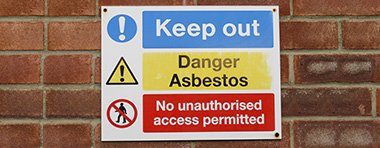How Can I Find Out if I Have Been Exposed to Asbestos?

Though asbestos has been strictly regulated in the U.S. for decades, the mineral can still be found in many buildings, ships, and automobiles. Until the 1970s, asbestos was widely used in construction, shipbuilding, and the automotive industries to produce products such as boilers, pipe covering, roofing products, insulation, cement pipe, vinyl floor tile, cement wallboard, and clutch, brake, and transmission components. This means that anyone who worked (or currently works) in these industries may be at risk of asbestos exposure. Exposure can occur during the demolition or remodeling of a home or other building, or while repairing or servicing an automobile or ship.
Other people at risk include those living in homes or working in buildings or schools where asbestos is damaged. Asbestos is most hazardous when it is “friable,” meaning the asbestos is easily crumbled by hand, releasing fibers into the air. When these fibers are inhaled or ingested, they can pass deep into the lungs or the digestive tract (if swallowed).
Because asbestos fibers are too small to be seen with the naked eye, there is no way to know when they are being ingested or inhaled. However, there are ways to find out if you have been exposed.
The most common test used to learn if you have been exposed to asbestos is a chest X-ray. Though a chest X-ray cannot detect the asbestos fibers themselves, it can detect early signs of disease caused by asbestos. Other tests, such as lung scanning and computer-aided tomography (CAT scan), are also useful in detecting changes in the lungs. Biopsy is another option.
Doctors may use X-ray and CAT scans to detect changes in the abdomen as well (peritoneal mesothelioma), and other tests such as laparoscopy may be used to look inside the abdomen and biopsy any peritoneal tumors. Blood tests such as Osteopontin and Soluble mesothelin-related peptides (SMRPs), detected with the MesoMark, are other newer, effective options, as blood levels of certain substances are often higher in people with mesothelioma.
Certain symptoms could be a sign of asbestos exposure or disease as well, so see your doctor if you are experiencing chest pain, shortness of breath, painful coughing, fatigue, unexplained weight loss, difficulty swallowing, abdominal pain and swelling, or lumps of tissue in the abdomen.
Sources
American Cancer Society. American Cancer Society, Inc., 2017. Web. 17 Oct. 2017.
“U.S. Federal Bans on Asbestos.” EPA.gov. Environmental Protection Agency, 2017. Web. 17 Oct. 2017.
"Health Affects: Asbestos." Minnesota Department of Health. Minnesota Department of Health, 2017. Web. 17 Oct. 2017.
"When Is Asbestos Dangerous?" Environmental Health and Safety. Oregon State University (OSU), 21 July 2009. Web. 17 Oct. 2017.



